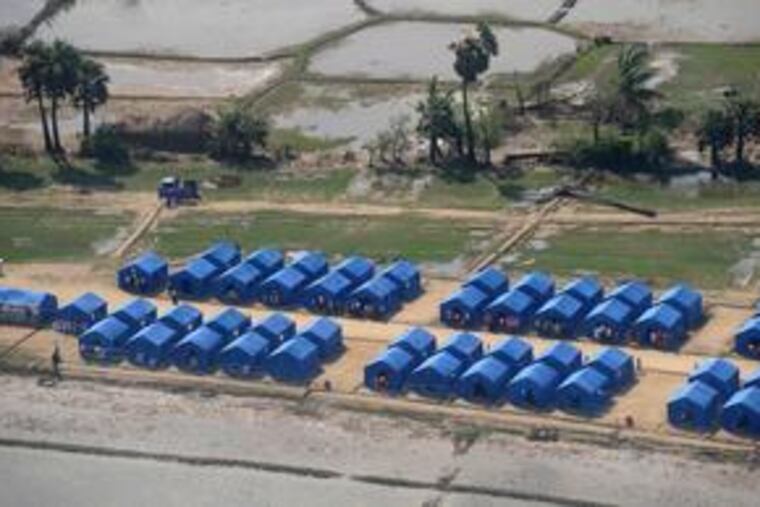U.N. chief shaken by Myanmar tour
The junta allowed a scripted flyover. Cyclone ruins he did not see are even worse.

KYONDAH, Myanmar - U.N. Secretary-General Ban Ki-moon flew over Myanmar's flooded Irrawaddy Delta yesterday, where the ravages of a cyclone stretched as far as the eye could see: Villages were empty of life, flattened huts dissolved into vast areas of water, and people perched on rooftops.
Nearly three weeks after the storm, life was grim even at a refugee camp showcased by Myanmar's junta during the carefully scripted tour.
"I'm very upset by what I've seen," Ban said, visibly shaken by the firsthand look at the devastation, even though the areas to which he was taken were far from those worst hit by Cyclone Nargis.
Before his helicopter flyover, Ban had said he was bringing a "message of hope" to Myanmar's people after the May 2-3 cyclone, which killed more than 78,000 people, according to government figures, and left more than 56,000 missing.
Myanmar's military rulers have been eager to show that they have the relief effort under control despite spurning the help of foreign disaster experts, and much of the tour was taken up by statistics-laden lectures to make that point.
The United Nations says up to 2.5 million cyclone survivors face hunger, homelessness, and potential outbreaks of deadly diseases, especially in the low-lying areas of the Irrawaddy Delta close to the sea. It estimates that aid has reached only 25 percent of victims.
The four-hour tour yesterday included two stops - one at Mawlamyinegyun, an aid-distribution point stocked with bags of rice and cartons of bottled water, and a makeshift camp where 500 people huddled in tents in the village of Kyondah, about 45 miles southwest of Yangon.
Still, the destruction in the region was relatively mild compared with Labutta and Bogalay to the south, where the Red Cross said rivers were full of corpses and many people had received no aid.
Kyondah, which has electricity and clean water, is something of a showcase and was selected for visits by foreign embassy officials and aid organizations last week.
At the camp, Ban was given a detailed explanation by Maj. Gen. Lun Thi of how Kyondah, formerly a cluster of seven villages with a population of 5,228, has expertly handled relief efforts. The village had 122 dead and missing, he said. He displayed charts saying the camp had 300 bags of rice, 64 boxes of instant noodles, 1,500 eggs, 12,000 bottles of drinking water, and 1,240 pieces of preserved meat.
While the general spoke, Ban sat in the front row of an elaborately constructed sitting room where bowls of fruit and soda were served. Ban ate and drank nothing.
Once the lecture was over, he strode into the camp, stopping at tents to look in on the homeless families, some with children as young as a day old.
"The whole world is trying to help Myanmar," he told one family in the camp.
So far, no one at the United Nations has said how long the delta is expected to remain submerged. But yesterday, Ban said he expected relief operations to be needed for at least six months.
In Bangkok, Thailand, yesterday, relief agencies said that they were finally breaking through a logjam created by the Myanmar government and that a small but steady flow of aid had begun. The first of 10 helicopters from the U.N. World Food Program arrived yesterday, said Marcus Prior, a spokesman for the agency.
Relief flights into Myanmar have increased to about 10 a day, officials said, and a distribution system is taking shape; trucks and barges have been contracted to carry supplies into the delta, and more relief workers are receiving visas.
U.N. officials traveling with Ban said they were discussing with Chinese authorities whether Ban could tour the earthquake zone in Sichuan, where a 7.9-magnitude earthquake hit May 12, after leaving Myanmar.